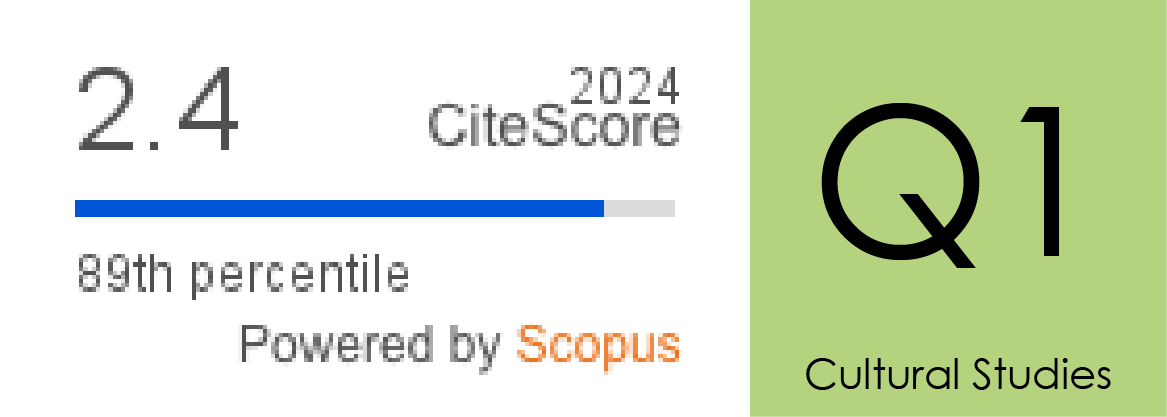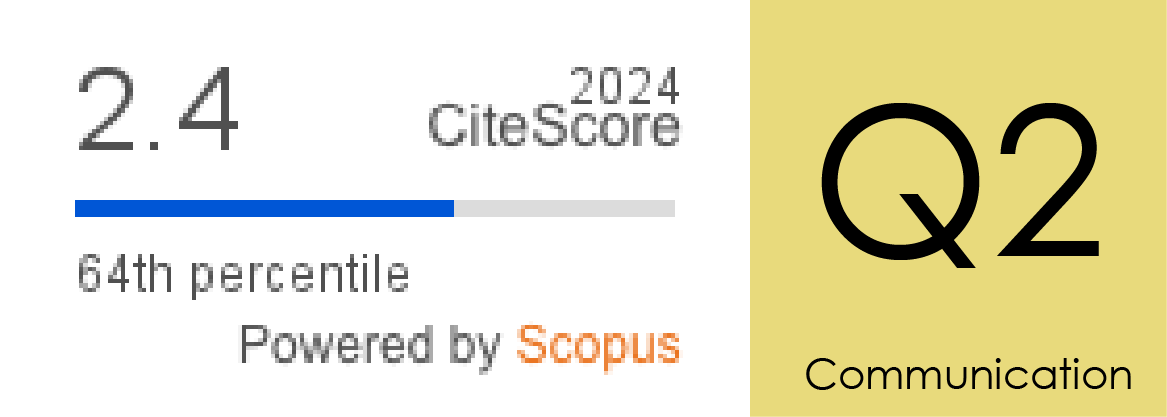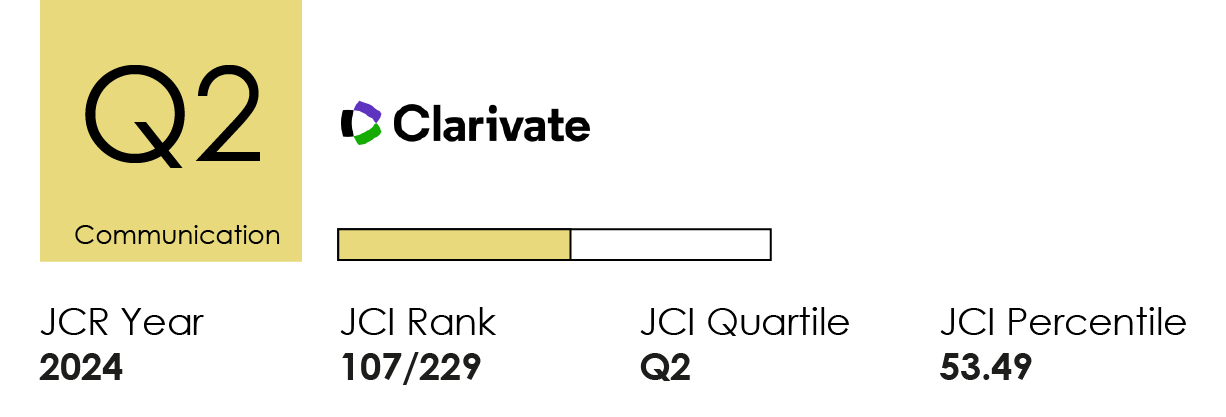Narrativas mediáticas sobre los trastornos de la conducta alimentaria en la prensa española (2012-2022): representación, discursos y estigmatización
DOI:
https://doi.org/10.14198/MEDCOM.29182Palabras clave:
Análisis de contenido, Anorexia nerviosa, imagen corporal, Trastornos de la conducta alimentaria, Bulimia nerviosa, estigmatización, Narrativa mediáticaResumen
Propósito. Analizar cómo la prensa española representa los trastornos de la conducta alimentaria (TCA) a través de relatos personales y evaluar el impacto de estas narrativas en la percepción social de estas patologías. Metodología. Se realizó un análisis de contenido sobre 136 artículos de cuatro diarios españoles (El País, ABC, La Vanguardia y El Mundo) entre 2012 y 2022, identificando patrones de representación y características de los protagonistas. Resultados y conclusiones. Los hallazgos confirman que las historias de TCA en los medios están protagonizadas mayoritariamente por mujeres (93.38%), especialmente jóvenes de entre 20 y 35 años (52.94%). La anorexia nerviosa es el trastorno más representado (63.24%), mientras que otras patologías, como la bulimia nerviosa (17.65%) o el trastorno por atracón (15.44%), reciben menos atención. Los testimonios analizados se centran en figuras mediáticas con reconocimiento popular (74.26%), vinculando los TCA con la industria del entretenimiento y reforzando estereotipos socioculturales que pueden ser estigmatizantes. Aportación original. Este estudio aporta una perspectiva crítica sobre el papel de los medios en la construcción de discursos sobre los TCA y subraya la necesidad de estrategias comunicativas que eviten enfoques reduccionistas y contribuyan a una comprensión más completa y empática de estas patologías.
Citas
Ali, K., Farrer, L., Fassnacht, D. B., Gulliver, A., Bauer, S., & Griffiths, K. M. (2017). Perceived barriers and facilitators towards help-seeking for eating disorders: A systematic review. International Journal of Eating Disorders, 50(1), 9-21. https://doi.org/10.1002/eat.22598
Alonso González, M. (2018). La comunicación científica en la prensa digital española: radiografía de sus fuentes informativas. Communication Papers. Media Literacy and Gender Studies, 7(13), 55–80. https://doi.org/10.33115/udg_bib/cp.v7i13.21984
American Psychiatric Association (2013). Diagnostic and statistical manual of mental disorders: DSM-5. American Psychiatric Association Publishing. https://doi.org/10.1176/appi.books.9780890425596
American Psychiatric Association (2022). Diagnostic and statistical manual of mental disorders: DSM-5 (R). American Psychiatric Association Publishing. https://doi.org/10.1176/appi.books.9780890425787
AIMC - Asociación para la investigación de medios de comunicación. (n.d.). Estudio General de los Medios en España. Madrid, Spain: AIMC. http://www.aimc.es/-Datos-EGM-Resumen-General-.html
Arcelus, J., Mitchell, A. J., Wales, J., & Nielsen, S. (2011). Mortality rates in patients with anorexia nervosa and other eating disorders. a meta-analysis of 36 studies. Archives of General Psychiatry, 68(7), 724–731. https://doi.org/10.1001/archgenpsychiatry.2011.74
Barakat, S., McLean, S.A., Bryant, E. Le, A., Marks, P., National Eating Disorder Research Consortium, Touyz, S., Maguire, S. (2023). Risk factors for eating disorders: findings from a rapid review. Journal of Eating Disorders. 11, 8. https://doi.org/10.1186/s40337-022-00717-4
Benaissa Pedriza, S. (2018). Las redes sociales como fuente de información periodística en la prensa digital española (El País, El Mundo, La Vanguardia y ABC). index.comunicación, 8(3),13-42. Retrieved from: https://indexcomunicacion.es/index.php/indexcomunicacion/article/view/401
Bratman, S. (1997) Health Food Junkie: Obsession with dietary perfection can sometimes do more harm than good, says one who has been there. Yoga Journal, 136, 42-46. https://www.scirp.org/reference/referencespapers?referenceid=3750833
Carrasco, J. M., Gómez-Baceiredo, B., Navas, A., Krawczyk, M., García, M., & Centeno, C. (2019). Social representation of palliative care in the Spanish printed media: A qualitative analysis. PloS one, 14(1), e0211106. https://doi.org/10.1371/journal.pone.0211106
Costa Sánchez, C. (2008). Medicina y salud en la prensa. Las noticias de salud en los principales diarios de Galicia. Revista Latina de Comunicación Social, 63, 15–21. https://doi.org/10.4185/rlcs-63-2008-750-015-021
Culbert, K. M., Racine, S. E., & Klump, K. L. (2015). What we have learned about the causes of eating disorders - A synthesis of sociocultural, psychological, and biological research. Journal of Child Psychology and Psychiatry, 56(11), 1141–1164. https://doi.org/10.1111/jcpp.12441
Daugelat, M. C., Pruccoli, J., Schag, K., & Giel, K. E. (2023). Barriers and facilitators affecting treatment uptake behaviours for patients with eating disorders: A systematic review synthesising patient, caregiver and clinician perspectives. European eating disorders review: the journal of the Eating Disorders Association, 31(6), 752–768. https://doi.org/10.1002/erv.2999
De Valle, M. K., Gallego-García, M., Williamson, P., & Wade, T. D. (2021). Social media, body image, and the question of causation: Meta-analyses of experimental and longitudinal evidence. Body Image, 39, 276–292. https://doi.org/10.1016/j.bodyim.2021.10.001
Donini, L. M., Barrada, J. R., Barthels, F., Dunn, T. M., Babeau, C., Brytek-Matera, A., Cena, H., Cerolini, S., Cho, H., Coimbra, M., Cuzzolaro, M., Ferreira, C., Galfano, V., Grammatikopoulou, M. G., Hallit, S., Håman, L., Hay, P., Jimbo, M., Lasson, C., Lindgren, E … Lombardo, C. (2022). A consensus document on definition and diagnostic criteria for orthorexia nervosa. Eating and Weight Disorders, 27(8), 3695–3711. https://doi.org/10.1007/s40519-022-01512-5
Fábregas, M., Tafur, A., Guillén, A., Bolaños, L., Méndez, J. L. & Fernández de Sevilla, P. (2018). Guía de estilo sobre salud mental para medios de comunicación: las palabras sí importan. Confederación Salud Mental. https://rb.gy/csw8eq
Fairburn, C. G., Cooper, P. J., & O’Connor, M. (1983). Publicity and bulimia nervosa. British Journal of Psychiatry, 142(1), 101–102. https://doi.org/10.1017/S000712500011414X
Feng, B., Harms, J., Chen, E., Gao, P., Xu, P., & He, Y. (2023). Current discoveries and future implications of eating disorders. International Journal of Environmental Research and Public Health, 20(14), 6325. https://doi.org/10.3390/ijerph20146325
Figuereo-Benítez, J. C., Esquiaqui-Buelvas, J., Moya López, D., & Mancinas-Chávez, R. (2024). El tratamiento informativo de las protestas en Colombia de 2021 en la prensa española: El País, El Mundo, La Vanguardia y ABC. Anuario Electrónico de Estudios en Comunicación Social "Disertaciones", 17(1), 1-21. https://doi.org/10.12804/revistas.urosario.edu.co/disertaciones/a.13286
Franssen, G. (2020). The celebritization of self-care: The celebrity health narrative of Demi Lovato and the sickscape of mental illness. European Journal of Cultural Studies, 23(1), 89-111. https://doi.org/10.1177/1367549419861636
Galmiche, M., Déchelotte, P., Lambert, G., & Tavolacci, M. P. (2019). Prevalence of eating disorders over the 2000–2018 period: a systematic literature review. The American Journal of Clinical Nutrition, 109(5), 1402–1413. https://doi.org/10.1093/AJCN/NQY342
Ging, D., & Garvey, S. (2017). ‘Written in these scars are the stories I can’t explain’: A content analysis of pro-ana and thinspiration image sharing on Instagram. New Media & Society, 20(3), 1181-1200. https://doi.org/10.1177/1461444816687288
Gollust, S. E., Fowler, E. F., & Niederdeppe, J. (2019). Television news coverage of public health issues and implications for public health policy and practice. Annual Review of Public Health, 40, 167–185. https://doi.org/10.1146/annurev-publhealth-040218-044017
Grabe, S. L., Ward, M., & Hyde, J. S. (2008). The role of the media in body image concerns among women: a meta-analysis of experimental and correlational studies. Psychological Bulletin, 134(3), 460–476. https://doi.org/10.1037/0033-2909.134.3.460
Guallar, J. (2017). Artículos de curación de contenidos. Categorías y ejemplos. Anuario ThinkEPI, 11, 210–216. https://doi.org/10.3145/thinkepi.2017.38
Guallar, J., Pedraza-Jiménez, R., Pérez-Montoro, M., and Anton, L. (2021). Curación de contenidos en periodismo. indicadores y buenas prácticas. Revista Española de Documentación Científica, 44(2), e296. https://doi.org/10.3989/redc.2021.2.1742
Guerro-Prado, D. & Barjau-Romero, J. M. (2002). Televisión, medios de comunicación escritos y su relación con los trastornos de la conducta alimentaria. Medicina Clínica, 119(17), 666–670. https://doi.org/10.1016/S0025-7753(02)73533-1
Guzmán do Nascimento, B. & Rodríguez Díaz, R. (2016). Comunicación y salud: la anorexia a través de la prensa. Estudios Sobre El Mensaje Periodístico, 22(2), 747–758. https://doi.org/10.5209/esmp.54233
Habermas, T. (1992). Further evidence on early case descriptions of anorexia nervosa and bulimia nervosa. International Journal of Eating Disorders, 11(4), 351–359. https://doi.org/10.1002/1098-108X(199205)11:4<351::AID-EAT2260110409>3.0.CO;2-A.
Habibagahi, K., Ferrari, M. (2024). Advocacy through storytelling: challenging eating disorders and eating disorders stigma. Journal of Eating Disorders, 12, 145. https://doi.org/10.1186/s40337-024-01099-5
Halbeisen, G., Laskowski, N., Brandt, G., Waschescio, U., & Paslakis, G. (2024). Eating Disorders in Men. Deutsches Arzteblatt international, 121(3), 86–91. https://doi.org/10.3238/arztebl.m2023.0246
Harrison, K. & Hefner, V. (2009). Media, body image, and eating disorders. In S. L. Calvert & B. J. Wilson (Eds.), The handbook of children, media, and development (pp. 381–406). Blackwell Publishing Ltd. https://doi.org/10.1002/9781444302752.ch17
Herrick, S. S. C., Hallward, L., & Duncan, L. R. (2021). "This is just how I cope": An inductive thematic analysis of eating disorder recovery content created and shared on TikTok using #EDrecovery. The International journal of eating disorders, 54(4), 516–526. https://doi.org/10.1002/eat.23463
Holmes, S. (2018). (Un)Twisted: Talking back to media representations of eating disorders. Journal of Gender Studies, 27(2), 149–164. https://doi.org/10.1080/09589236.2016.1181539
Huang, Q., Peng, W., & Ahn, S. (2020). When media become the mirror: A meta-analysis on media and body image. Media Psychology, 24(4), 437–489. https://doi.org/10.1080/15213269.2020.1737545
Huckins, L. M., Signer, R., Johnson, J., Wu, Y., Mitchell, K. S & Bulik, C. M. (2022). What next for eating disorder genetics? Replacing myths with facts to sharpen our understanding. Molecular Psychiatry, 27(10), 3929–3938. https://doi.org/10.1038/s41380-022-01601-y
Lai, C., Pellicano, G. R., Iuliano, S., Ciacchella, C., Sambucini, D., Gennaro, A., & Salvatore, S. (2021). Why people join pro-ana online communities? A psychological textual analysis of eating disorder blog posts. Computers in Human Behavior, 124, 106922. https://doi.org/10.1016/j.chb.2021.106922
Levine, M. P., & Maine, M. (2010). Are media an important medium for clinicians? Mass media, eating disorders, and the bolder model of treatment, prevention, and advocacy. In M. Maine; B. Hartman McGilley; W Douglas and D. W. Bunnell (Eds.), Treatment of eating disorders: bringing the research practice gap (pp.53-67). Academic Press. https://doi.org/10.1016/B978-0-12-375668-8.10004-X
Levitt, H. M. (1997) A semiotic understanding of eating disorders: The impact of media portrayal. Eating Disorders, 5(3), 169–183. https://doi.org/10.1080/10640269708249223
McCombs, M. E. & Shaw, D. L (1972). The agenda-setting function of mass media. The Public Opinion Quarterly, 36(2), 176–187. http://www.jstor.org/stable/2747787
Maciá-Barber, C. (2013). Ética, fotoperiodismo e infancia: Imagen del conflicto palestino-israelí en España. Cuadernos. info, (33), 89-98. http://dx.doi.org/10.7764/cdi.33.528
MacLean, A., Sweeting, H., Walker, L., Patterson, C., Räisänen, U., &Hunt, K. (2015). “It’s not healthy and it’s decidedly not masculine”: A media analysis of UK newspaper representations of eating disorders in males. BMJ Open, 5(5), e007468 https://doi.org/10.1136/BMJOPEN-2014-007468
Malova, E., & Dunleavy, V. (2021). Men have eating disorders too: an analysis of online narratives posted by men with eating disorders on YouTube. Eating Disorders, 30(4), 437–452. https://doi.org/10.1080/10640266.2021.1930338
Martín Llaguno, M. (2010). Historia mediática de la anorexia. La construcción inicial del problema a finales de los 90. Revista ICONO14. Revista Científica de Comunicación y Tecnologías Emergentes, 8(3), 45–61. https://doi.org/10.7195/ri14.v8i3.228
Mondini, S., Favaro, A., & Santonastaso, P. (1996). Eating disorders and the ideal of feminine beauty in Italian newspapers and magazines. European Eating Disorders Review, 4(2), 112-120. https://doi.org/10.1002/(SICI)1099-0968(199606)4:2<112::AID-ERV152>3.0.CO;2-6
Murray, S., Touyz, S. & Beumont, P. (1990). Knowledge about eating disorders in the community. International Journal of Eating Disorders, 9(1), 87–93. https://doi.org/10.1002/1098-108X(199001)9:1<87::AID-EAT2260090110>3.0.CO;2-2
O’Brien, K. M., Whelan, D. R., Sandler, D. P., Hall, J. E., & Weinberg, C. R. (2017). Predictors and long-term health outcomes of eating disorders. PloS one, 12(7), e0181104. https://doi.org/10.1371/JOURNAL.PONE.0181104
O’Hara, S. & Clegg-Smith, K. (2007). Presentation of eating disorders in the news media: What are the implications for patient diagnosis and treatment? Patient Education and Counseling, 68(1), 43–51. https://doi.org/10.1016/j.pec.2007.04.006
Qian, J., Wu, Y., Liu, F., Zhu, Y., Jin, H., Zhang, H., Wan, Y., Li, C., & Yu, D. (2022). An update on the prevalence of eating disorders in the general population: A systematic review and meta-analysis. Eating and Weight Disorders, 27(2), 415-428. https://doi.org/10.1007/s40519-021-01162-z
Regan, P., Cachelin, F. M., & Minnick, A. M. (2017). Initial treatment seeking from professional health care providers for eating disorders: A review and synthesis of potential barriers to and facilitators of “first contact”. International Journal of Eating Disorders, 50(3), 190-209. https://doi.org/10.1002/eat.22683
Revuelta, G., Llorente, C., Penela, C. G. & Moena Latasa, O. (2023). Informe Quiral 2022-2023: La gravedad de la salud mental: comunicación y percepción. Fundació Vila Casas y Centro de Estudios de Ciencia, Comunicación y Sociedad (Universitat Pompeu Fabra). https://doi.org/10.5281/zenodo.8177359
Rodgers, R. F., Berry, R., and & Franko, D. L. (2018). Eating disorders in ethnic minorities: An update. Current Psychiatry Reports, 20(90). https://doi.org/10.1007/s11920-018-0938-3
Ronco López, M., Peñafiel, C., & Echegaray, L. (2014). El periodismo de salud en la prensa española (2000-2010). Aproximación a los estudios documentales existentes. Documentación de las ciencias de la información, 37, 267–304. https://doi.org/10.5209/rev_DCIN.2014.v37.46827
Saguy, A. C & Gruys, K. (2010). Morality and health: News media constructions of overweight and eating disorders. Social Problems, 57(2), 231–250. https://doi.org/10.1525/SP.2010.57.2.231
Santillán Buelna, J. R., & Zuart Garduño, A. (2021). La construcción informativa de México en la prensa española de referencia: La Vanguardia, El País y El Mundo. Ámbitos. Revista Internacional de Comunicación, (54), 84-103. http://dx.doi.org/10.12795/Ambitos.2021.i54.05
Saukko, P. (2006). Rereading media and eating disorders: Karen Carpenter, Princess Diana, and the healthy female self. Critical Studies in Media Communication, 23(2), 152–169. https://doi.org/10.1080/07393180600714539
Saukko, P. (2008). The Anorexic Self: a personal and political analysis of a diagnostic discourse. State University of New York Press. https://shorturl.at/rZ8TX
Schmidt, U., Adan, R., Böhm, I., Campbell, I. C., Dingemans, A., Ehrlich, S., Elzakkers, I., Favaro, A., Giel, K., Harrison, A., Himmerich, H., Hoek, H. W., Herpertz-Dahlmann, B., Kas, M. J., Seitz, J., Smeets, P., Sternheim, L., Tenconi, E., van Elburg, A., van Furth, E., & Zipfel, S. (2016). Eating disorders: The big issue. The Lancet Psychiatry, 3(4), 313–315. https://doi.org/10.1016/S2215-0366(16)00081-X
Seale, C. (2003). Media and health. Sage Publications Ltd. https://doi.org/10.1111/1467-9566.t01-1-00356
Shepherd, E, & Seale, C. (2010). Eating disorders in the media: The changing nature of UK newspaper reports. European Eating Disorders Review, 18(6), 486–495. https://doi.org/10.1002/erv.1006
Strother, E., Lemberg, R., Stanford, S. C., & Turberville, D. (2012). Eating disorders in men: underdiagnosed, undertreated, and misunderstood. Eating Disorders, 20(5), 346–355. https://doi.org/10.1080/10640266.2012.715512
Sweeting, H., Walker, L., MacLean, A., Patterson, C., Räisänen, U. & Hunt, K. (2015). Prevalence of eating disorders in males: A review of rates reported in academic research and UK mass media. International Journal of Men’s Health, 14(2), 10.3149/jmh.1402.86. https://doi.org/10.3149/jmh.1402.86
Taquet, M., Geddes, J., R; Luciano, S. & Harrison, P. J. (2022). Incidence and outcomes of eating disorders during the covid-19 pandemic. British Journal of Psychiatry, 220(5), 262–264. https://doi.org/10.1192/bjp.2021.105
Thompson, K. J., Heinberg, L. J., Altabe, M., & Tantleff-Dunn, S. (1999). Exacting beauty: Theory, assessment, and treatment of body image disturbance. American Psychological Association. https://doi.org/10.1037/10312-000
Van Eeden, A. E., Van Hoeken, D. & Hoek, H. W. (2021). Incidence, prevalence and mortality of anorexia nervosa and bulimia nervosa. Current Opinion in Psychiatry, 34(6), 515-524. https://doi.org/10.1097/YCO.0000000000000739
Van Hoeken, D. & Hoek, H. W. (2020). Review of the burden of eating disorders: Mortality, disability, costs, quality of life, and family burden. Current Opinion in Psychiatry. 33(6), 521–527. https://doi.org/10.1097/YCO.0000000000000641
Van Leeuwen, T., & Jaworski, A. (2002). The discourses of war photography. Journal of Language and Politics, 1(2), 255-275. https://doi.org/10.1075/jlp.1.2.06lee
Van Malderen, E., De Coen, J., Taquet, J., & Goossens, L. (2023). The role of family factors in eating disorders. In: Robinson, P., Wade, T., Herpertz-Dahlmann, B., Fernandez-Aranda, F., Treasure, J. & Wonderlich, S. (Eds), Eating Disorders: An international comprehensive view. Cham: Springer International Publishing. https://doi.org/10.1007/978-3-030-97416-9_26-1
Descargas
Estadísticas
Publicado
Cómo citar
Número
Sección
Licencia
Derechos de autor 2018 Maria Comabella-Costa, Marta Consuegra-Fernández, Joan-Gabriel Burguera-Serra

Esta obra está bajo una licencia internacional Creative Commons Atribución 4.0.
Los autores y autoras que publican en esta revista están de acuerdo con los siguientes términos:
1 Derechos de autor. Los autores y autoras conservan sus derechos de autor, aunque ceden a la revista de forma no exclusiva los derechos de explotación (reproducción, distribución, comunicación pública y transformación) y garantizan a esta el derecho de primera publicación de su trabajo, el cual estará simultáneamente sujeto a la licencia indicada en punto 2. Los autores pueden establecer otros acuerdos adicionales para la distribución no exclusiva de la versión de la obra publicada en la revista, siempre que exista un reconocimiento de su publicación inicial en esta revista.
© Los autores.
2 Licencia. Los trabajos se publican en la revista sujetos a la licencia de Reconocimiento 4.0 Internacional de Creative Commons (CC BY 4.0); los términos se pueden consultar en https://creativecommons.org/licenses/by/4.0/
Esta licencia permite a terceros compartir (copiar y redistribuir el material en cualquier medio o formato) y adaptar (remezclar, transformar y crear a partir del material para cualquier finalidad, incluso comercial), siempre que se reconozca la autoría y la primera publicación en esta revista (Revista Mediterránea de Comunicación (RMC) / Mediterranean Journal of Communication (MJC), Universidad de Alicante, DOI de la obra), se proporcione un enlace a la licencia y se indique si se han realizado cambios en la obra.
3 Política de autoarchivo. Se recomienda a los autores que difundan sus trabajos a través de Internet para favorecer una circulación y difusión más rápidas y, con ello, un posible aumento en la citación y alcance entre la comunidad científica y académica, en las siguientes condiciones:
No se permite a los autores depositar en un repositorio institucional o temático, página web propia, etc., las versiones preprint (versión antes de ser evaluada) o postprint (versión evaluada y aceptada para su publicación) de sus trabajos antes de su publicación, pero sí el artículo final publicado (versión del editor).













